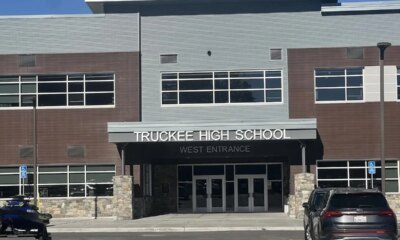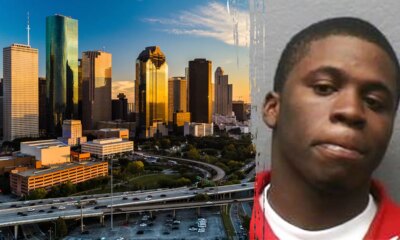Business
Wildfires Will Deepen Housing Shortage in Los Angeles

Each of the homes burned in the Los Angeles fires is its own individual calamity.
Collectively, the losses — whether in the hundreds or, as is far more likely, in the thousands — will weigh on the city’s already urgent housing shortage.
Fires are still raging, and with 180,000 people under evacuation orders as of Thursday morning, the degree of displacement in the city and its surrounding areas will take time to assess. For the time being, evacuees are holing up in public shelters in Los Angeles County, with friends or family members or in hotels.
But in the coming weeks and months, people whose homes are gone will have to find more stable accommodations while they rebuild. That will not be easy in a metro area that, as of 2022, already had a shortage of about 337,000 homes, according to data from Zillow. The number of homes on the market in Los Angeles was 26 percent below prepandemic norms as of December, according to Zillow.
“One of the biggest challenges ahead will be getting people who lost their homes into permanent, long-term housing,” Victor M. Gordo, the mayor of Pasadena, said on Wednesday. Pasadena, which is battling the Eaton fire, has already lost hundreds of homes.
The area’s tight rental market is likely to become further strained as many of the thousands of displaced residents turn to rental units, while figuring out their next move. The median rent for a one-bedroom apartment in Los Angeles, as of Jan. 7, was more than $2,000, according to Zillow.
“You’re going to have a positive shock in demand, and a negative shock in supply, so this automatically means prices go up in the rental markets,” said Carles Vergara-Alert, a professor of finance at IESE Business School in Barcelona, who has studied the effects of wildfires on housing markets.
Any uptick in rental costs would affect tenants across the region, beyond those displaced by the fires, Dr. Vergara-Alert said.
Jonathan Zasloff, who lost his home in Pacific Palisades this week, teaches land use and urban policy at the University of California, Los Angeles law school, and is acutely aware of how his search for interim housing could affect the broader market.
Dr. Zasloff is staying with his brother for the time being, while a friend is putting up his wife and daughter. They evacuated their house, which they had lived in for almost 15 years, around noon on Tuesday, before the official evacuation order was issued for the area. That evening, Dr. Zasloff realized the severity of the crisis when he was watching television and saw a reporter standing on his fire-ravaged block.
His insurance agent told him it could take two to three years to rebuild his house. His family might try to find a rental in West Los Angeles near UCLA in the meantime, he said.
There aren’t many rentals in that part of the city, Dr. Zasloff said, so students and other renters could be displaced as he, and people like him who lost their homes, move in.
“It’s very possible that this event is going to cause a big increase in homelessness, even though the people who got pushed out of their homes are people of means,” he said.
California has been in the grip of an affordable housing crisis for a decade. Both state and local lawmakers have passed a raft of new laws that aim to make housing cheaper and more plentiful by making it easier to build. In Los Angeles, for instance, Mayor Karen Bass signed an executive order that streamlines permitting for projects in which 100 percent of the units are affordable. In response to state housing reforms, there has been a boom of backyard homes — called accessory dwelling units, or A.D.U.s — that homeowners often rent out for extra income and that have added to the housing stock.
Still, both the city and state remain well behind their housing production goals, and affordability has only continued to erode. The number of apartment units approved by the city of Los Angeles, for example, dipped to a 10-year low in 2024, according to data from the Los Angeles Department of Building and Safety compiled by Crosstown LA, a news site. That downturn in building permitting has raised concern about roadblocks to new housing unit creation.
“This is a place that had massive affordability challenges last week, and after this week it’s going to be that much more challenging,” said Dave Rand, a land-use lawyer at Rand Paster & Nelson in Los Angeles, who also serves on the board of directors of a statewide affordable housing organization.
After the fires are extinguished and the recovery begins, Mr. Rand said, there is hope that the common cause of rebuilding can be a catalyst for tackling affordability challenges by continuing to make it easier to build housing, particularly affordable rental housing, at a faster pace.
“This is such a devastating event that hopefully it rocks the system to the point where we can get real reform,” he said.
The Los Angeles City Council has aimed to build nearly half a million new units by 2029. But many people trying to rebuild all at once after the fires could lead to higher costs, and slow down the overall production of housing, said Jason Ward, a co-director of the center on housing and homelessness at the RAND Corporation.
A longstanding construction labor shortage in Los Angeles does not help. Andy Howard, a general contractor who has worked across the city for three decades, including in the areas affected by the fires, said many of the subcontractors he work with in the past have left California since the pandemic. And there are not enough young people entering the industry.
The fires are “going to make it worse,” Mr. Howard said. “It’s going to drive the cost up, for sure.”

Business
Courts rejects bid to beef up policies issued by California’s home insurer of last resort

Retired nurse Nancy Reed has been through the ringer trying to get insurance for her home next to a San Diego County nature preserve.
First, she was dropped by her longtime carrier and forced onto the state’s insurer of last resort, the California FAIR Plan, which offers basic fire policies — something thousands of residents have experienced at the hands of fire-leery insurance companies.
But what she didn’t expect was how hard it would be to find the extra coverage she needed to augment her FAIR Plan policy, which doesn’t cover common perils such as water damage or liability if someone is injured on a property.
She secured the “difference-in-conditions” policies from two insurers, only to be dropped by both before finally finding another for her Escondido home.
“I’ve lived in this house for 25 years, and I went from a very fair price to ‘we’re not insuring you anymore’ — and I’ve had three different difference-in-conditions policies,” said Reed, 71, who is paying about $2,000 for 12 months of the extra coverage. “And I’m holding my breath to see if I will be renewed next year.”
Now, a Department of Insurance regulation that would have required the FAIR plan to offer that additional coverage has been blocked by a state appeals court — leaving the plan’s customers to find that insurance in a market widely considered dysfunctional.
The court ruled earlier this month that the order would have forced the plan to offer liability insurance, which was not the intent of the Legislature when it established the plan in 1968 to offer essential insurance for those who couldn’t get it.
“We appreciate that the court confirmed the California FAIR Plan is designed and intended to operate as California’s insurer of last resort, providing basic property coverage when it cannot be obtained in the voluntary market,” said spokesperson Hilary McLean.
Insurance Commissioner Ricardo Lara said he is “looking at all available options” following the decision. “I’ve been fighting so people can have access to all of the coverage the FAIR Plan is required by law to provide,” he said in a statement.
Lara has faced criticism from consumer advocates who’ve called for his resignation over his response to the state’s ongoing property insurance crisis.
A FAIR Plan policy covers fires, lightning, smoke damage and internal explosions, as well as vandalism and some other hazards at an additional cost. But in addition to water damage and liability protection, it doesn’t cover such common perils as theft and the damage caused by trees falling on a house.
The demand for the additional coverage — commonly referred to as a “wrap-around” policy — has become even greater than in 2021 when Lara issued the order overturned on appeal.
The FAIR Plan at the time had about 160,000 active dwelling policies following a series of catastrophic wildfires, including the 2018 fire that nearly destroyed the mountain town of Paradise. By September, that number had grown to 646,000.
The insurance department lists less than two dozen companies that offer wrap-around policies, including major California home insurers such as Mercury and Farmers and a a number of smaller carriers.
Broker Dina Smith said that to find the coverage for her home insurance clients she needs to place about 90% of them with carriers not regulated by the state — with the combined coverage typically costing at least twice as much as a regular policy.
“The [market] is very limited,” said Smith, a managing director at Gallagher.
Safeco has not written California wrap-around coverage since the beginning of the year and will begin non-renewing existing policies next month. Smith also said carriers are being selective, with the ones that offer the coverage often demanding exclusions, such as for certain types of water damage.
“If I’ve got a newer home with no prior claims … for liability losses, it’s going to be easy to write. If I get a home that is built in the 1950s that might still have galvanized pipes … that’s going to be a tough one,” she said.
Attorney Amy Bach, executive director of United Policyholders, a San Francisco consumer group, said the difference-in-conditions, or DIC, market is getting just as problematic for homeowners as the overall market.
“The market is not as strong as it needs to be … given how many people are in the FAIR Plan, and there aren’t as many DIC options — with the DIC companies being just as picky as the primary insurers,” she said.
There is also confusion about the policies, she said. Her group is considering pushing for a law next year that would clearly label the coverage so consumers better understand what they are buying.
Business
Student Loan Borrowers in Default Could See Wages Garnished in Early 2026

The Trump administration will begin to garnish the pay of student loan borrowers in January, the Department of Education said Tuesday, stepping up a repayment enforcement effort that began this year.
Beginning the week of Jan. 7, roughly 1,000 borrowers who are in default will receive notices informing them of their status, according to an email from the department. The number of notices will increase on a monthly basis.
The collection activities are “conducted only after student and parent borrowers have been provided sufficient notice and opportunity to repay their loans,” according to the email, which was unsigned.
The announcement comes as many Americans are already struggling financially, and the cost of living is top of mind. The wage garnishing could compound the effects on lower-income families contending with a stressed economy, employment concerns and health care premiums that are set to rise for millions of people.
The email did not contain any details about the nature of the garnishment, such as how much would be deducted from wages, but according to the government’s student aid website, up to 15 percent of a borrower’s take-home pay can be withheld. The government typically directs employers to withhold a certain amount, similar to a payroll tax.
A borrower should be sent a notice of the government’s intent 30 days before the seizure begins, according to the website, StudentAid.gov.
The administration ended a five-year reprieve on student loan repayments in May, paving the way for forced collections — meaning tax refunds and other federal payments, like Social Security, could be withheld and applied toward debt payments.
That move ushered in the end of pandemic-era relief that began in March 2020, when payments were paused. More than 9 percent of total student debt reported between July and September was more than 90 days delinquent or in default, according to the Federal Reserve Bank of New York. In April, only one-third of the 38 million Americans who owed money for college or graduate school and should have been making payments actually were, according to government data.
“It’s going to be more painful as you move down the income distribution,” said Michael Roberts, a professor of finance at the Wharton School at the University of Pennsylvania. But, he added, borrowers have to contend with the fact that they did take out money, even as government policies allowed many to put the loans at the back of their minds.
After several extensions by the Biden administration, payments resumed in October 2023, but borrowers were not penalized for defaulting until last year. About five million borrowers are in default, and millions more are expected to be close to missing payments.
The government had signaled this year that it would send notices that could lead to the garnishing of a portion of a borrower’s paycheck. Being in collections and in default can damage credit scores.
The government garnished wages before the pandemic pause, said Betsy Mayotte, president of the Institute of Student Loan Advisors, which provides free advice for borrowers. But the 2020 collections pause was the first she was aware of, she said, and that may make the deductions more shocking for people who have not had to pay for years.
“There’s a lot of defaulted borrowers that think that there was a mistake made somewhere along the line, or the Department of Education forgot about them,” Ms. Mayotte said. “I think this is going to catch a lot of them off guard.”
The first day after a missed payment, a loan becomes delinquent. After a certain amount of time in delinquency, usually 270 days, the loan is considered in default — the kind of loan determines the time period. If someone defaults on a federal student loan, the entire balance becomes due immediately. Then the loan holder can begin collections, including on wages.
But there are options to reorganize the defaulted loans, including consolidation or rehabilitation, which requires making a certain number of consecutive payments determined by the holder.
Often, people who default on debt owe the smallest amounts, said Constantine Yannelis, an economics professor at the University of Cambridge who researches U.S. student loans.
“They’re often dropouts or they went to two-year, for-profit colleges, and people who spent many, many years in schools, like doctors or lawyers, have very low default rates,” he said.
This year, millions of borrowers saw their credit scores drop after the pause on penalties was lifted. If someone does not earn an income, the government can take the person to court. But, practically speaking, a borrower’s credit score will plummet.
Dr. Yannelis added that a common reason people default was that they were not aware of the repayment options. There are plans that allow borrowers to pay 10 percent of their income rather than having 15 percent garnished, for example.
The whiplash policy changes around the time of the pandemic were “a terrible thing from a borrower-welfare perspective,” Dr. Yannelis said. “Policy uncertainty is really terrible for borrowers.”
Business
Kevin Costner’s western ‘Horizon’ faces more claims of unpaid fees

In the midst of attempting to complete filming on his western anthology ”Horizon: An American Saga,” Kevin Costner is facing another legal dispute over the production.
On Monday, Western Costume Co. sued Costner and the production companies behind the epic western, claiming unpaid costume fees and damages to some of the clothing during the filming of the series’ second episode.
“The costumes are costly to replace if damaged or not returned,” states the complaint, which included copies of invoices for about $134,000 in costume rentals. “Without a reasonable basis for doing so and/or with reckless regard to the consequences, defendants failed to pay for the rented costumes and failed to return the costumes undamaged.”
Western Costume, the iconic business based in North Hollywood, is seeking to recover roughly $440,000, including legal fees, according to the lawsuit filed Monday in Los Angeles Superior Court.
A spokesperson for Costner did not immediately respond to a request for comment.
The lawsuit is the latest in a series of legal and financial problems that have dogged the sprawling western drama, which Costner directed, co-wrote, starred in and partially funded.
In May, United Costume Corp., sued the production, claiming $350,000 in unpaid fees for the first two chapters of “Horizon.” Two months later, the costume firm filed to dismiss the suit with prejudice.
In May, Devyn LaBella, a stunt performer on “Chapter 2,” sued the production for sexual discrimination, harassment and retaliation in Los Angeles Superior Court. LaBella alleged an unscripted rape scene was filmed without the presence of a contractually mandated intimacy coordinator.
In a motion filed in August to get the suit tossed, Costner said he had reviewed LaBella’s complaint and was “shocked at the false and misleading allegations she was making.”
In October, a Los Angeles Superior Court judge denied Costner’s anti-SLAPP motion to dismiss the case. The judge also denied LaBella’s claim that Costner had interfered with her civil rights through the use of intimidation or coercion with respect to her participation in the filming of a rape scene, but allowed several of her other claims to proceed.
The case is pending.
The production is also facing an arbitration claim for alleged breaches in its co-financing agreement with its distributor New Line Cinema and City National Bank, “Horizon” bondholder, according to the Hollywood Reporter.
In June 2024, “Chapter 1” of the planned four-part series was released in theaters followed by a streaming broadcast on HBO Max, but it was largely panned by critics.
In its review, The Times described “Horizon” as “a massive boondoggle, a misguided and excruciatingly tedious cinematic experience.”
It failed at the box office, grossing just $38.8 million worldwide, on a reported $100 million budget.
“Chapter 2” premiered at the Venice International Film Festival last September, but its theatrical release was pulled and remains indefinitely delayed, while the final two chapters remain in production or development, according to IMDb.
-

 Iowa1 week ago
Iowa1 week agoAddy Brown motivated to step up in Audi Crooks’ absence vs. UNI
-

 Maine1 week ago
Maine1 week agoElementary-aged student killed in school bus crash in southern Maine
-

 Maryland1 week ago
Maryland1 week agoFrigid temperatures to start the week in Maryland
-

 New Mexico1 week ago
New Mexico1 week agoFamily clarifies why they believe missing New Mexico man is dead
-

 Detroit, MI1 week ago
Detroit, MI1 week ago‘Love being a pedo’: Metro Detroit doctor, attorney, therapist accused in web of child porn chats
-

 Health1 week ago
Health1 week ago‘Aggressive’ new flu variant sweeps globe as doctors warn of severe symptoms
-

 Massachusetts1 week ago
Massachusetts1 week agoMIT professor Nuno F.G. Loureiro, a 47-year-old physicist and fusion scientist, shot and killed in his home in Brookline, Mass. | Fortune
-

 Maine1 week ago
Maine1 week agoFamily in Maine host food pantry for deer | Hand Off

























